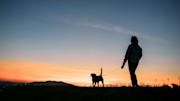
Pet insurance
5% pet insurance discount
Co-op members get a 5% discount on Co-op Pet Insurance each year. Subject to minimum yearly total costs of £51.59 for dogs and £50.68 for cats.

Walks are one of the best and most important parts of your dog’s day. They keep your dog fit, happy and calm - and they’re great for humans too. A daily walk gives both of you time to relax, enjoy fresh air and bond.
If you're a first time dog owner, however, it’s easy to forget just how much there is to think about before heading out. Taking your dog for a walk might seem like a very simple task, but being prepared helps make the activity safer and more enjoyable for both you and your dog. These tips will help you get ready and stay confident on every dog walk.
Start by checking your dog’s lead and collar. They should fit securely but not too tightly - you should be able to slide 2 fingers between the collar and your dog’s neck. A snug fit helps keep your dog safe and makes it less likely they’ll slip free if they get startled. You can also consider a harness for added protection.
Your dog’s collar should have an ID tag with your address or phone number. Many people like to include their dog’s name, but it’s usually safer not to - it can make it easier for someone to call your dog away if they’re trying to take them.
It’s a legal requirement for your dog to be microchipped from 8 weeks of age. It’s also your responsibility to ensure that your contact details are kept up to date on an approved database. A correct microchip record means your dog can be quickly traced back to you if they ever go missing.
Think about how easy it is for others to see you, especially in winter or at night. A light-coloured coat or clothing with reflective parts can help drivers and cyclists notice you sooner. A hi-vis vest, reflective harness or a small light clipped onto your dog’s collar makes them stand out too. Even during the day, bright colours can help both of you stay visible in busy areas.
If you plan to let your dog off the lead, make sure their recall is strong. This means they come back straight away when you call them. Good recall keeps your dog safe around roads, other dogs and wildlife. If you’re not confident yet, practice in quiet parks or fenced areas first.
It’s also a good idea to do this at less busy times, like early morning. Use treats, toys and praise to make coming back to you rewarding. Keep your dog on the lead in busy areas until you’re sure they’ll respond every time.
Always check the weather before setting off. Hot pavements can burn paws, while cold or wet weather can make some dogs uncomfortable. A quick test is to touch the pavement with your hand — if it’s too hot or too cold for you, it’s the same for your dog. On hot days, walk early in the morning or later in the evening when it’s cooler.
Bring at least 2 dog poo bags so you can clean up after your dog - it keeps parks and paths safe for everyone and helps stop the spread of illness. Do not be embarrassed to ask another dog walker for one if you run out; most people are happy to help.
Always carry some fresh water, especially on warm days or longer walks. Dogs can get dehydrated quickly, so stop for short drink breaks even if they do not seem thirsty. A few treats are also handy for recall training, keeping their attention, or rewarding calm behaviour around other dogs and people.
Keep an eye out for dangers such as broken glass, sharp sticks, or litter that could injure your dog’s paws. Some plants, like foxglove and blue-green algae near ponds, can be harmful if eaten, so steer your dog away if they start sniffing something which looks unusual.
If you’re walking through the countryside, follow the signs and stick to the local rules. Keep your dog on a lead near livestock or wildlife, even if they’re usually well-behaved. A sudden movement can trigger a chase instinct in any dog. Sticking to paths also helps protect farmland and wildlife habitats.
Socialising is an important part of your dog’s wellbeing. Meeting other dogs and people helps build their confidence and teaches them to stay calm in new situations. Watch how your dog reacts - if they seem nervous or unsure, give them space and try again another time. With regular, positive experiences, they’ll become more relaxed and friendly on walks.
After a walk, especially on muddy or wet days, give your dog’s paws a quick clean with a towel or pet wipe. This stops dirt spreading indoors and helps protect your dog’s skin. Dogs often lick their paws clean themselves, but wiping away grit, mud or road salt helps keep them comfortable.
If you’ve been walking through long grass or woodland, check your dog for ticks. Run your hands gently over their fur and look out for any small lumps on the skin. Regular tick treatments from your vet can help prevent bites and reduce the risk of illness.
There’s a lot to think about before and during a dog walk, but once you build a routine it soon becomes second nature. A bit of planning helps keep your dog safe, comfortable and happy - and makes walks more relaxing for you too. With the right preparation, every walk can be a fun, safe and rewarding part of your day together.